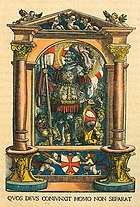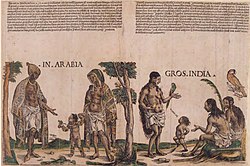Hans Burgkmair
Hans Burgkmair | |
|---|---|
 The painter Hans Burgkmair and his wife Anna (painting byLukas Furtenagel,1529) | |
| Born | 1473 Augsburg,Germany |
| Died | 1531 (aged 57–58) Augsburg, Germany |
| Nationality | German |
| Known for | Painting,printmaking,woodcut |
Hans Burgkmair the Elder(1473–1531) was a Germanpainterandwoodcutprintmaker.
Background
[edit]Hans Burgkmair was born inAugsburg,the son of painterThomas Burgkmair.His own son, Hans the Younger, later became a painter as well.[1]From 1488, Burgkmair was a pupil ofMartin SchongauerinColmar.Schongauer died in 1491, before Burgkmair was able to complete the normal period of training. He may have visited Italy at this time, and certainly did so in 1507, which greatly influenced his style. From 1491, he worked in Augsburg, where he became a master and eventually opened his own workshop in 1498. Burgkmair was a Lutheran.[2]
Career
[edit]
German art historian Friedrich Wilhelm Hollstein ascribes 834 woodcuts to Burgkmair, the majority of which were intended for book illustrations. Slightly more than a hundred are "single-leaf" prints which were not intended for books. His work shows a talent for striking compositions which blend Italian Renaissance forms with the established German style.
From about 1508, Burgkmair spent much of his time working on thewoodcutprojects ofMaximilian Iuntil the Emperor's death in 1519.[1]He was responsible for nearly half of the 135 prints in theTriumphs of Maximilian,which are large and full of character. He also did most of the illustrations forWeisskunigand much ofTheuerdank.He worked closely with the leading blockcutterJost de Negker,who became in effect his publisher.[3]
He was an important innovator of thechiaroscuro woodcut,and seems to have been the first to use a tone block, in a print of 1508.[4]HisLovers Surprised by Death(1510) is the first chiaroscuro print to use three blocks,[5][failed verification]and also the first print that was designed to be printed only in colour, as the line block by itself would not make a satisfactory image. Other chiaroscuro prints from around this date byBaldungandCranachhad line blocks that could be and were printed by themselves.[6]He produced one etching,Venus and Mercury(c1520),[7]etched on a steel plate, but never triedengraving,despite his training withSchongauer.
Burgkmair was also a successful painter, mainly of religious scenes, portraits of Augsburg citizens, and members of the Emperor's court. Many examples of his work are in the galleries ofMunich,Viennaand elsewhere.[8]
Burgkmair died at Augsburg in 1531.
Burgkmair and the foundation of modern ethnology
[edit]Burgkmair's time was a period of development for ethnography and the new Humanist science ofchorography(promoted byConrad Celtesat theUniversity of Vienna).[9][10]Using commercial ventures of the Welsers in Augsburg as a pretext, the humanistKonrad Peutingergoaded Emperor Maximilian into backing his ethnographical interests in the Indians and supporting the 1505–1506 voyage of Balthasar Springer around Africa to India.[11][12]Based on an instruction dictated by Maximilian in 1512 regarding Indians in theTriumphal Procession,Jörg Kölderer executed a series of (now lost) drawings, which served as the guideline forAltdorfer'sminiatures in 1513–1515, which in turn became the model for woodcuts (half of them based on now lost 1516–1518 drawings by Burgkmair) showing "the people of Calicut."[13]In 1508, Burgkmair produced thePeople of Africa and Indiaseries, focusing on depicting the peoples whom Springer encountered along coastal Africa and India.[11]The series brought into being "a basic set of analytic categories that ethnography would take as its methodological foundation".[14]
Gallery
[edit]-
Print in theTriumphs ofMaximilian
-
Altarpiece of John the Evangelist, 1518 (Alte Pinakothek)
See also
[edit]Notes
[edit]- ^abGietmann 1908.
- ^Carey, F.; Museum, B. (1999).The Apocalypse and the Shape of Things to Come.University of Toronto Press. p. 148.ISBN978-0-8020-8325-8.Retrieved2022-10-11.
- ^Landau & Parshall, 212
- ^"Emperor Maximilian on Horseback".Artbma.org. Archived fromthe originalon 2007-01-06.
- ^"Lovers Surprised by Death".Archived fromthe originalon 2017-06-25.Retrieved2006-11-06.
- ^The Renaissance Print, David Landau & Peter Parshall, Yale, 1996,ISBN0-300-06883-2
- ^"Hans (the Younger) Burgkmair".Artnet.de.
- ^Chisholm 1911.
- ^Poe, Marshall T. (1 January 2002).A People Born to Slavery ": Russia in Early Modern European Ethnography, 1476–1748.Cornell University Press. p. 119.ISBN978-0-8014-7470-5.Retrieved24 December2021.
- ^Vogel, Klaus A. (2003)."Cosmography".InPark, Katharine;Daston, Lorraine(eds.).The Cambridge History of Science: Volume 3, Early Modern Science.Cambridge University Press. p. 488.ISBN978-0-521-57244-6.Retrieved24 December2021.
- ^abNoflatscher 2011,p. 236.
- ^Leitch, Stephanie (June 2009)."Burgkmair's Peoples of Africa and India (1508) and the Origins of Ethnography in Print"(PDF).The Art Bulletin.91(2): 134–159.doi:10.1080/00043079.2009.10786162.S2CID194043304.Retrieved24 December2021.
- ^Feest, Christian (August 2014)."The people of Calicut: objects, texts, and images in the Age of Proto-Ethnography".Boletim do Museu Paraense Emílio Goeldi. Ciências Humanas.9(2): 295–296.doi:10.1590/1981-81222014000200003.S2CID84828234.
- ^Leitch 2009,p. 135.
References
[edit]- Chisholm, Hugh,ed. (1911)..Encyclopædia Britannica.Vol. 4 (11th ed.). Cambridge University Press. p. 817.
 This article incorporates text from a publication now in thepublic domain:Gietmann, Gerhard (1908). "Hans Burckmair".In Herbermann, Charles (ed.).Catholic Encyclopedia.Vol. 3. New York: Robert Appleton Company.
This article incorporates text from a publication now in thepublic domain:Gietmann, Gerhard (1908). "Hans Burckmair".In Herbermann, Charles (ed.).Catholic Encyclopedia.Vol. 3. New York: Robert Appleton Company.- Noflatscher, Heinz (2011).Maximilian I. (1459 - 1519): Wahrnehmung - Übersetzungen - Gender(in German). StudienVerlag. p. 245.ISBN978-3-7065-4951-6.
External links
[edit] Media related toHans Burgkmair d. Ä.at Wikimedia Commons
Media related toHans Burgkmair d. Ä.at Wikimedia Commons- Burgkmair's Flodden woodcut
- Prints & People: A Social History of Printed Pictures,an exhibition catalog from The Metropolitan Museum of Art (fully available online as PDF), which contains material on Burgkmair (see index)
- Lambiek Comiclopedia biography.








